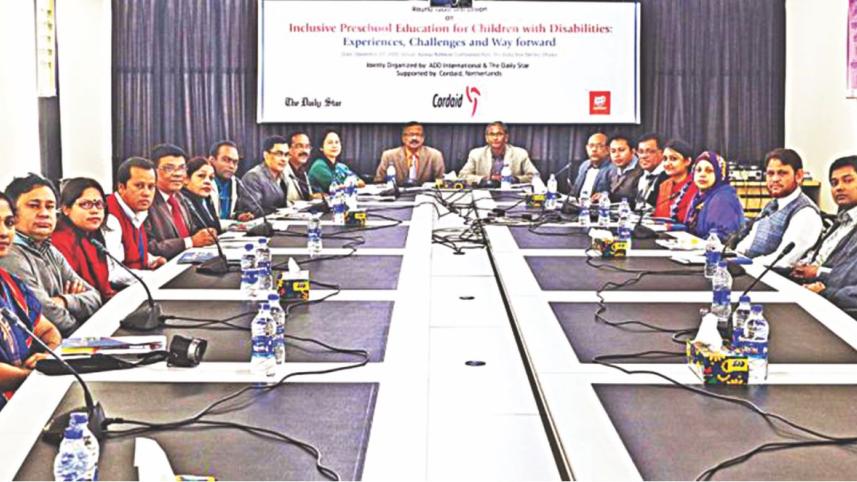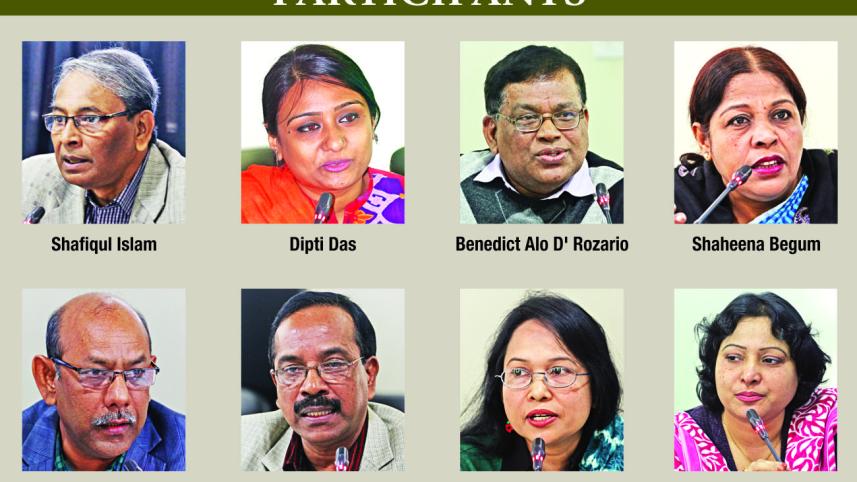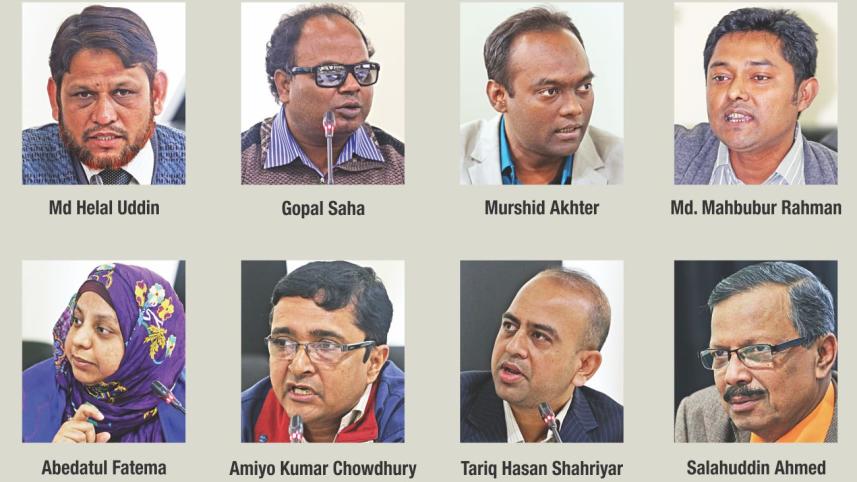Inclusive Preschool Education for Children with Disabilities: Experiences, Challenges and Way Forward

Shafiqul Islam, Country Director,
ADD International Bangladesh
Bangladesh has achieved tremendous success in primary school enrollment. But still majority of the children with disability remains out of primary school. This is a clear violation of the constitutional pledge of ensuring education for every child. Today, we will discuss on this crucial issue and share our opinion about creating an inclusive environment in educational institutions for CWDs, especially primary education.
Dipti Das, Consultant
Under the 'Inclusive Preschool Education for Children with Disabilities' project we conducted research in 15 schools of Tangail, Sirajganj and Dhaka City Corporation. Our study shows that learning environment at these schools is not inclusive. There is a lack of disability friendly WASH facilities, teaching tools and transportation systems in those schools. Parents also see CWDs as burden and often hide information about them. The key lessons we have learnt from the study include inclusive preschool education of both children with and without disabilities enhances interaction among children; infrastructural improvement appropriate for children with disability is a must; parents motivation and DPOs/Community participation in planning and operation of preschool needs to be further enhanced. To make the schools inclusive we need consistent programmes on motivating parents, creating community awareness and building capacity of the stakeholders. We need to ensure proper effective application of the training provided on inclusive education through classroom level follow-ups. Inclusive curriculum, teaching and learning methods also need to be developed. Finally, we have to do more researches to identify socio-economic barriers of CWD families as well as to document and disseminate lesson learned from various government and non-government interventions at national and international level.
Dr. Benedict Alo D' Rozario, Executive Director, Caritas Bangladesh
We should learn from good practices of other countries. In Tamil Nadu, there are hostels in schools for CWDs where they stay from Monday to Friday. The school authorities start class on Monday after usual time so that CWDs can reach school at ease. Again on Friday, classes are finished earlier so that CWDs can get extra time to reach home safely. This is an inspiring example. In Hong Kong, schools provide transport facility to CWDs. On holidays, school transports take them on outings. We should replicate these good practices in our country.
Shaheena Begum, District Primary Education Officer, Dhaka
Every year in December we do children survey to know the status of children's access to education. We should use the data to trace the uncared for CWDs and bring them to schools. Community members should also come forward in this regard.

Khondoker Ariful Islam, Country Director, Sight Savers International
We should involve non-education NGOs, Masjids, youth clubs and other village organisations in creating awareness among the community members. We can also form a special committee in every school to address the problems of CWDs students, and the committee will include parents, teachers and community leaders.
The social welfare ministry has one special school in each district. There are specially trained teachers in these schools who can provide training and other relevant supports to regular schools and their teachers.
According to the Persons with Disabilities Rights and Protection Act 2013, refusing any CWD to admit into a school is a punishable offence. But we do not see implementation of this Act. The government should look into this issue seriously. At the same time we need to equip our schools with necessary facilities for CWDs.
There should be more inter-ministerial coordination. We should also engage them more. Otherwise our recommendations will not reach them.
In our country, only six percent schools have toilet facilities for CWDs and fifteen percent have ramps. This is a very poor situation. LGRD Ministry should address this issue seriously.
Finally, there are different models of inclusive education practiced by different NGOs. Some of these pilot programmes are expensive and some are low-cost but ineffective. There should be coordination in our approach and programmes so that we can mainstream the most effective model of inclusive education.

Mohammad Shahidul Islam, Dhaka Ahsania Mission
NGOs should create a partnership to complement each other's work. For example, an education NGO will ensure CWDs' access to education while a transport related NGO will provide transport facility to make their movement comfortable.
Dilara Sattar Mitu, Executive Director, SEID
Education ministry should tie up with Social Welfare ministry to assess the needs of CWDs in schools. Social Welfare ministry has health centres for persons with disability where therapists can do the necessary assessment of a CWD and recommend the school authority what kind of support the child needs.
Still none of our school curriculum is disability friendly. Social Welfare ministry has developed a curriculum for people with disability. Education ministry can introduce this curriculum for CWDs in schools.
Inclusive education does not mean that CWDs have to attend the same classroom with regular students. Children with severe or profound disability will never be able to attend regular schools. There should be separate classrooms for these students. They might participate in some classes with regular students but for special classes they need separate arrangement. This must be mentioned in the curriculum. Moreover, Social Welfare Ministry should follow rights based approach, not charity based approach.
Shahnaz Parvin, Deputy Director, Inclusive Cell, Department of Primary Education
Primary Education Ministry has an action plan on pre-school inclusive education under which we are working with CWDs. We have initiated a teachers' training programme where we would train 64,000 primary school teachers on inclusive education. We have already appointed 10 teachers under the disability quota. We have to do a lot more. Still we cannot give text books to blind students on the very first day of the year. Here we need cooperation from the social welfare ministry because they provide books for CWDs. They also do survey of CWDs. It can be used for identifying marginalised students. With coordination and cooperation among different ministries we can better serve the CWDs.
In order to make our curriculum more inclusive, we keep regular contact with NCTB. We have directed the mainstream schools to admit children with mild and moderate disabilities. But children with profound disability have to go to special schools under the Social Welfare Ministry. England and Netherlands follow this approach. In the developed world, the ratio of regular and CWDs ranges from 12:1 to 20:1. That's why they can give proper attention to an individual student. But our classrooms are overcrowded. There are generally 60 to 100 students in each class. So taking special care of a CWD is really challenging for an individual teacher. So we need to consider the issue of class size seriously and try to reduce it as much as possible. We also need to practice individual education plan (IEP) in schools.
The Social Welfare Ministry still follows charity model. In order to ensure equal education for all, we need to follow the social model incorporating all the relevant stakeholders.
Md. Helal Uddin, Assistant Upazila Education Officer, Sirajganj Sadar
From my field level experience, I think the main challenge of inclusive education is attitude, both of parents and teachers. Usually parents of CWDs do not hold high expectation from their children, and that's why they are not interested in their education. Every school has a survey of local children and their needs. If we follow that survey no CWD should be left out of school facilities. We have achieved some progress in ensuring admission to schools for CWDs who have acceptable level of disability. But we have done very little for those children who are suffering from severe disabilities.
Gopal Saha, SEID
Only enrollment in school is not enough. We need to ensure meaningful participation of CWDs in the learning process. There should be a different evaluation standard for CWDs.
Murshid Akther, Research Officer, NCTB
It seems that we are confused about the idea of inclusivity. It means access for all. It does not mean that there will be a separate teaching process for CWDs. Rather it should be modeled in a way where all types of students can participate. For example, in a class on environment if the teacher asks students to tell about things they have perceived on their way to school rather than what have they seen then a visually impaired student will also be able to participate and share his view.
In Bangladesh we have prepared a comprehensive pre-primary curriculum which is a very good example in the world. In this curriculum there is a chapter on inclusive education with special focus on CWDs. It is totally based on activity. So, everyone can participate in the learning process.
Md. Mahbubur Rahman, Special Education Department, IER, University of Dhaka
When we talk about inclusive curriculum we should focus on equity not equality. Here the teacher has to be aware about a child's problem. Otherwise he will not be able to teach the student properly. So we need to follow separate teaching method for CWDs.
Abedatul Fatema, Save the Children International
Our pre-primary school curriculum is really rich. Now we need to implement it properly. That is the real challenge. We do not have sufficient number of teachers to execute this curriculum. Schools have to appoint separate teaching staff for pre-primary school. They also need to be trained round the year. NGO can help in the training process. During the refresher training we can instruct them about inclusive education method. Class room size is another big challenge. If the government wants to give access to education to all children it has to expand education facility because in a class of hundred students a teacher is not enough for taking care of every child separately.
Tamanna Khan, Journalist, The Daily Star
Recently The Daily Star published a report on a boy, named Russel, who lost both of his hands. Still he continues his drawing habit using his legs. He used to attend an NGO-run school. But after some time, he left the school. Talking to his parents, it seemed to us that they did not really bother about sending him back to school because now he could earn money by begging. The school authorities even told his parents that through proper treatment he could get back to normal life again but they were not interested. Though there is a monthly allowance scheme for students with disabilities it is not enough to motivate parents to keep their children in school. We should think about increasing the amount of government allowance and other supporting programmes to retain these children in schools.
Amiyo Kumar Chowdhury, Education Programme, Brac
Forty thousand CWDs have been studying in Brac schools around the country. We have training programmes in every Upazila. There, we arrange workshop for community leaders, government officials and NGO workers. We have undertaken some small scale income generation programmes for CWDs with the involvement of the community people. Now, CWDs can participate in the skill development trainings provided by BRAC. If we engage the community in this way they can play an important role in creating an inclusive environment for CWDs.
Tariq Hasan Shahriyar, Senior Reporter, The Daily Sun
We see high concentration of persons with disabilities (PWDs) in low-income areas, particularly in rural and urban slums. We have plan for PWDs in rural locations but there is no specific arrangement for urban slums that contains 40 percent of the total PWDs. And by 2030 it will be 50 percent due to rapid rural-urban migration. How can we include these marginalised people in our national programmes for PWDs?
Dr. Salahuddin Ahmed, The Daily Star
Given that we have 16 crore people, even if 2% of them are disable that is a huge number. To support this large of number people with disabilities we need participation of all the stakeholders. We need a better coordination among different government and non-government efforts.
Secondly, we should focus on raising awareness and changing attitude. During the 80s, massive awareness raising programmes were undertaken to combat diarrhea. There were advertisements in TV and radio on how to prevent diarrhea. Mosques and temples also played an important role in this regard. Eighty percent households of the country were covered under the programme. Now people are well informed about the treatment of diarrhea, and it is no more a threat for us. We know that it is not a disease, it is dehydration. We should learn from this proven campaign tactic.
We never discuss about disability in our universities. I teach post graduate students a course titled “NGOs and social entrepreneurship.” I often tell them a story of China. When I was in China, my wife and I wrote a case study on a company founded by a person with disability. He had to use wheel chair. He had been suffering from hemophilia that's why he needed blood transfusion every month. He established a company with one thousand disabled people. The company was involved in doing animations and developing software. You must have seen the movie Avatar. Part of its animation was done by this company. It is an example of what people with disability can achieve, if they get opportunity. My students also get inspired by this story. We should share such positive stories about the people with disabilities. It will change our attitude towards them. CWDs should be assimilated into regular classes. A student should not feel hesitant to sit beside a fellow student who happens to have disabilities. An important stakeholder here is the school authority. If the headmaster participates in raising awareness, other teachers will feel obliged to participate. I think ADD can take a leadership role in this social movement.



 For all latest news, follow The Daily Star's Google News channel.
For all latest news, follow The Daily Star's Google News channel.
Comments